
Overview
You might be wondering how to streamline your manufacturing operations effectively. Well, this article dives into the world of standard operating procedures (SOPs) and highlights some handy tools, like SowFlow, that can help you create and manage these SOPs with ease. The beauty of well-implemented SOPs is that they can boost productivity, ensure compliance, and maintain quality control—all while cutting down on operational risks. They provide clear guidelines that help keep everything consistent and efficient in your manufacturing processes. So, let’s explore how you can make this work for you!
Key Highlights:
- SowFlow simplifies the creation of manufacturing SOPs, allowing teams to document procedures directly from their browsers.
- Digital SOPs reduce paperwork, enabling teams to concentrate on core operational tasks and improve productivity.
- Effective SOPs enhance onboarding and knowledge sharing, ensuring clarity in processes and compliance with industry standards.
- Regular updates and reviews of SOPs are crucial to maintain relevance and adapt to changing regulations.
- Companies with strong SOPs experience improvements in compliance, quality control, and operational performance.
- Digital SOPs can include multimedia elements for better engagement and understanding among employees.
- Non-compliance with SOPs can lead to significant legal penalties, product recalls, and reputational damage.
- Involving employees in SOP reviews boosts adherence and understanding, leading to better operational efficiency.
Introduction
In the complex world of manufacturing, you might be wondering how the efficiency of operations really hinges on the clarity and consistency of standard operating procedures (SOPs). Well, by leveraging well-crafted SOPs, organizations can not only streamline their processes but also enhance compliance and quality control. But here’s the catch: the challenge lies in creating and maintaining these documents in a way that adapts to the ever-evolving manufacturing landscape. So, how can companies ensure their SOPs remain relevant and effective in driving operational excellence? Let’s explore ten compelling examples of manufacturing SOPs together, offering insights into best practices that can transform documentation into a powerful tool for success.
SowFlow: Instant SOP Creation for Enhanced Operational Efficiency
You might be wondering how to streamline your manufacturing processes with the help of manufacturing SOP examples. Well, SowFlow has got you covered with a unique solution that makes creating manufacturing SOP examples a breeze. Imagine being able to record your procedures right from your browser! This means your team can capture workflows accurately and efficiently, without the hassle of complicated documentation.
Speaking of efficiency, SowFlow leverages advanced technology to cut down the time spent on paperwork. This allows your teams to focus on what really matters—core operational tasks. And the best part? This capability not only boosts productivity but also ensures that your documentation, including manufacturing SOP examples, remains relevant and up-to-date, adapting seamlessly to the fast-paced changes in the manufacturing world. So, why not explore how SowFlow can transform your documentation process today?
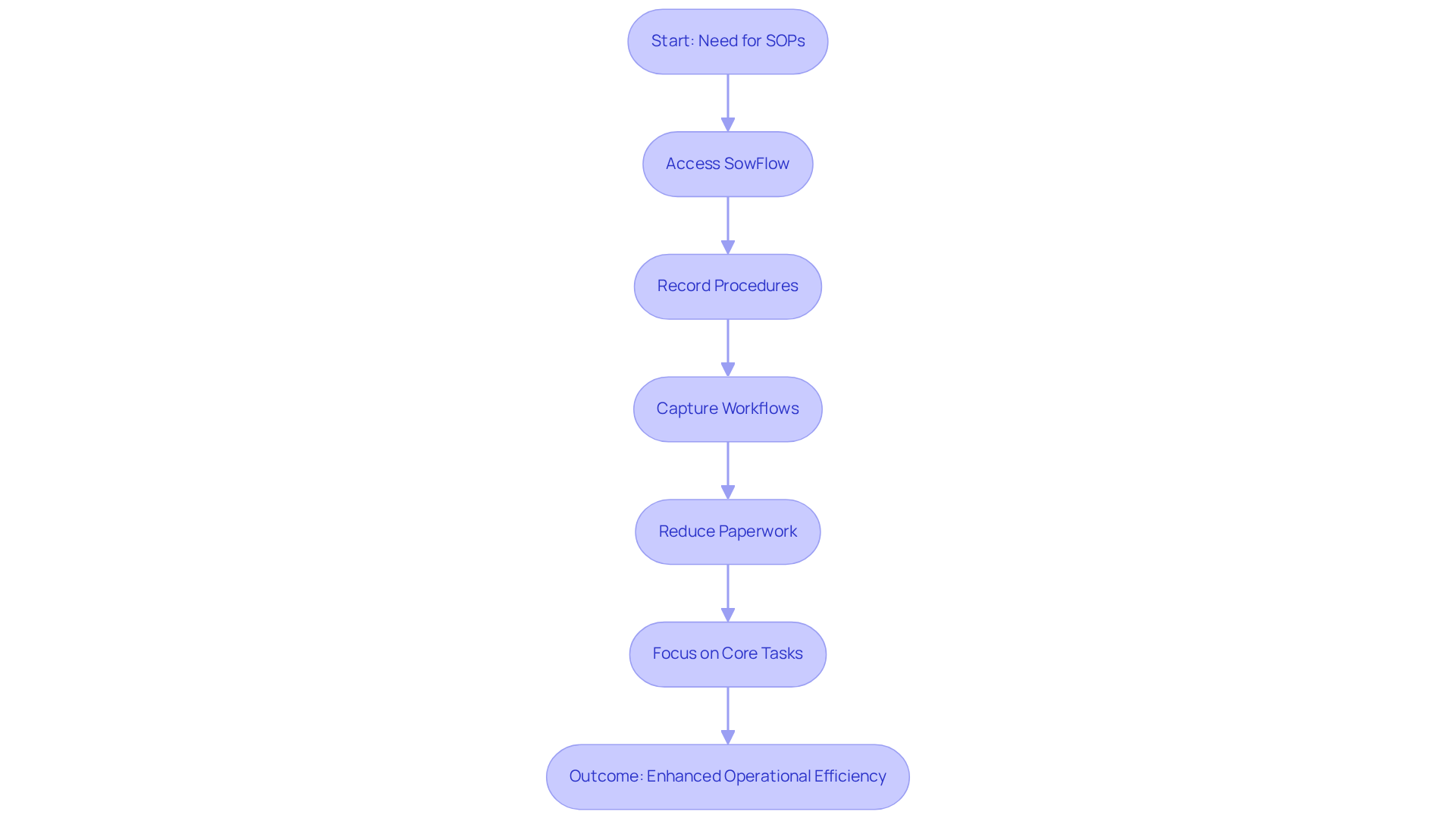
Document360: Writing Effective Standard Operating Procedures for Manufacturing
You might be wondering how to create efficient manufacturing SOP examples in a manufacturing setting. Well, SowFlow has got you covered! It offers a super straightforward way to craft these essential documents. With SowFlow, operations managers can whip up user guides in no time, making sure everything is crystal clear—like the purpose of the SOP, the scope, and those all-important step-by-step procedures.
Now, let’s dive into why this matters. By tapping into SowFlow's capabilities, companies can really streamline their process standardization. Think about it: enhanced onboarding and better knowledge sharing are crucial for training new employees and keeping up with industry standards. This organized approach means that your manufacturing SOP examples will be clear, concise, and easy to follow, which ultimately boosts team efficiency. So, why not explore how SowFlow can make your documentation challenges a breeze?
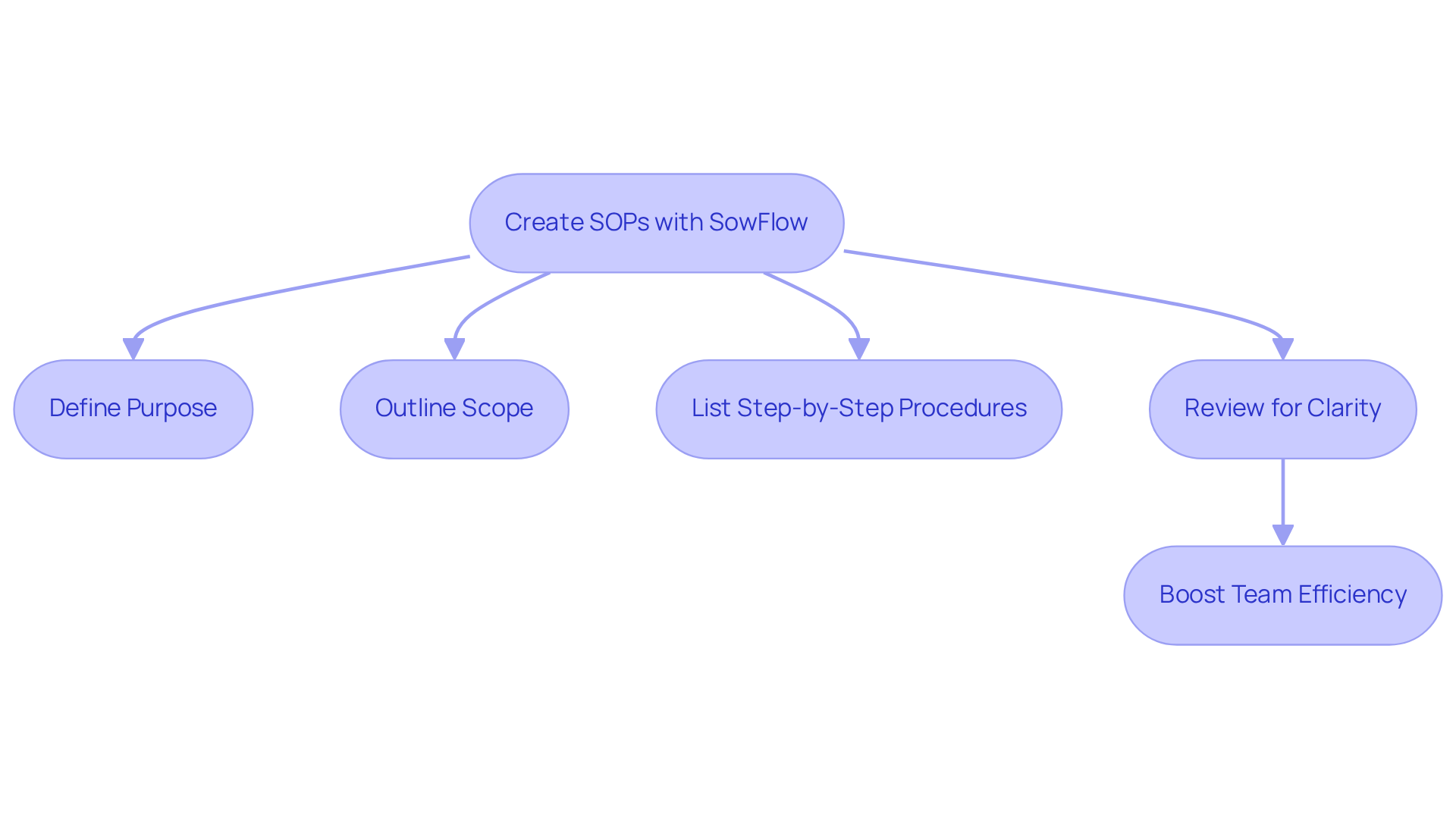
Ease.io: Creating Manufacturing SOPs for Quality and Compliance
You might be wondering why creating manufacturing procedures is such a big deal. Well, it’s crucial for ensuring quality and keeping things running smoothly in companies. When businesses implement procedures that align with regulatory standards, they can really cut down on errors and boost their operational efficiency. This kind of standardization not only protects against compliance hiccups but also makes processes flow better throughout the organization.
For instance, organizations that have put in place organized standard operating procedures (SOPs), such as manufacturing SOP examples, have seen a jump in their compliance with quality benchmarks. This leads to fewer operational risks and a boost in product reliability. Just take it from Anastasia Masadi, a Product Owner, who says, "SowFlow has been a game changer in the way we document work and deliver to our clients. I do not have to take each screenshot individually, and do not even need to exit the browser while I am creating standard operating procedures and training materials. SowFlow gave me time from my life back." It’s clear that SowFlow is making life easier and more efficient for teams by allowing them to record procedures without breaking their workflow.
Now, let’s dive into why effective manufacturing SOP examples are crucial. They provide a solid framework for employees, ensuring that tasks are carried out consistently and in line with industry regulations. Incorporating visual aids like flowcharts and diagrams can really simplify complex processes, making them easier to grasp. Plus, a clear numbering system can break down procedures into bite-sized steps, which enhances usability and makes everything less daunting.
This proactive approach to compliance doesn’t just protect the organization; it also nurtures a culture of continuous improvement and operational excellence. And remember, regularly monitoring and updating your SOPs is key to keeping them relevant and effective. This way, they can evolve alongside changing regulations and industry practices, ensuring that your organization stays ahead of the curve.
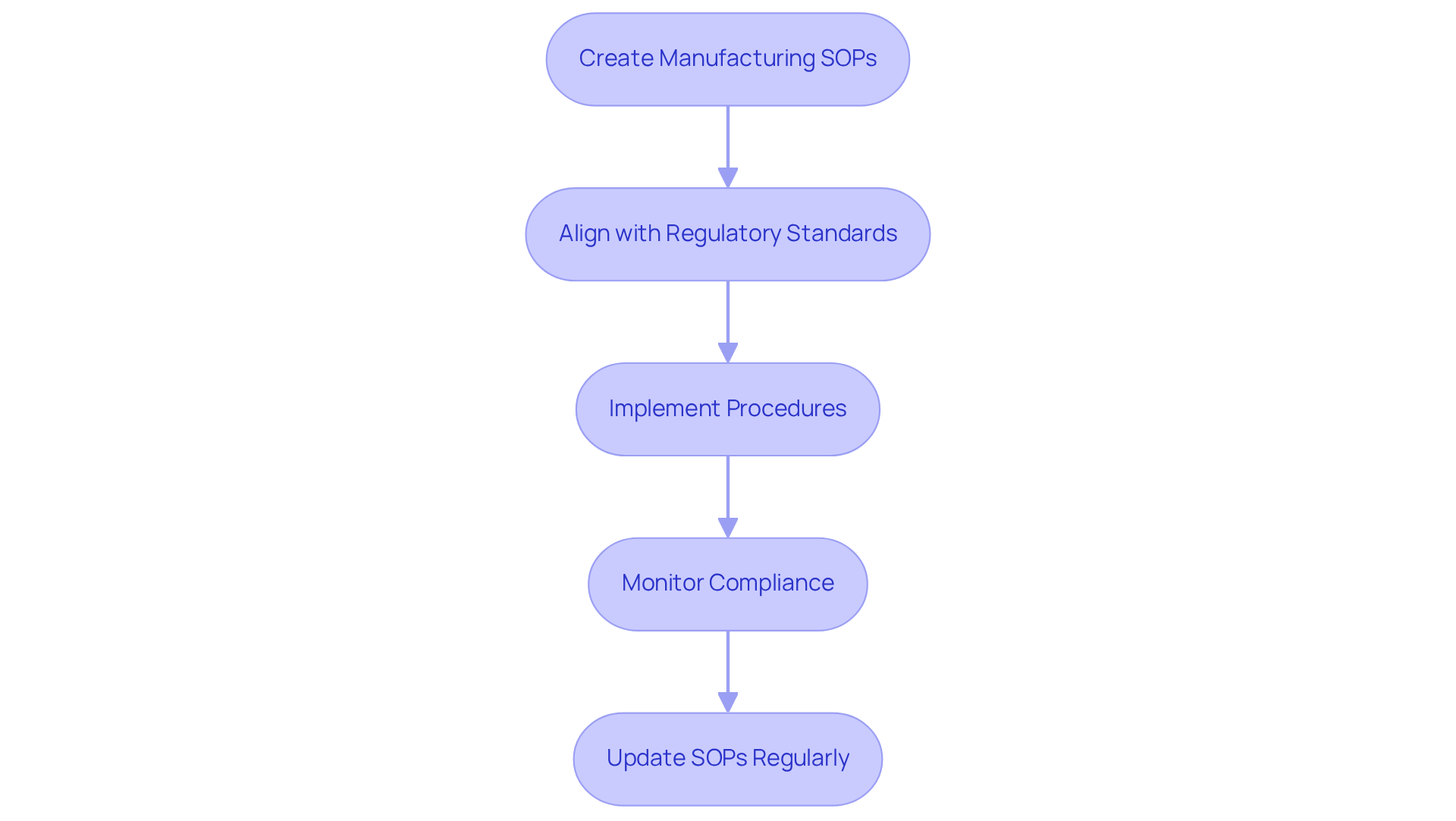
Fabriq.tech: Steps to Write Effective Manufacturing SOPs
You might be wondering how to create effective manufacturing SOP examples. Well, Fabriq.tech has provided manufacturing SOP examples that can help with a straightforward approach! First, you’ll want to identify the procedure you need to document. Then, gather all the necessary information, draft the SOP, and review it for clarity and accuracy. Involving the right stakeholders during the drafting phase is crucial—it ensures that the SOP reflects real-world practices and is practical for those who will use it.
Now, let’s dive into the importance of keeping your SOPs up to date. Frequent evaluations and revisions are essential to maintain relevance as procedures evolve. With SowFlow, your teams can take advantage of features like instant access to documentation and easy updates, making it a breeze to create user guides. To really maximize the effectiveness of your SOPs, consider scheduling regular review sessions. This way, you can ensure they stay aligned with current practices. So, what do you think? Are you ready to streamline your documentation process?
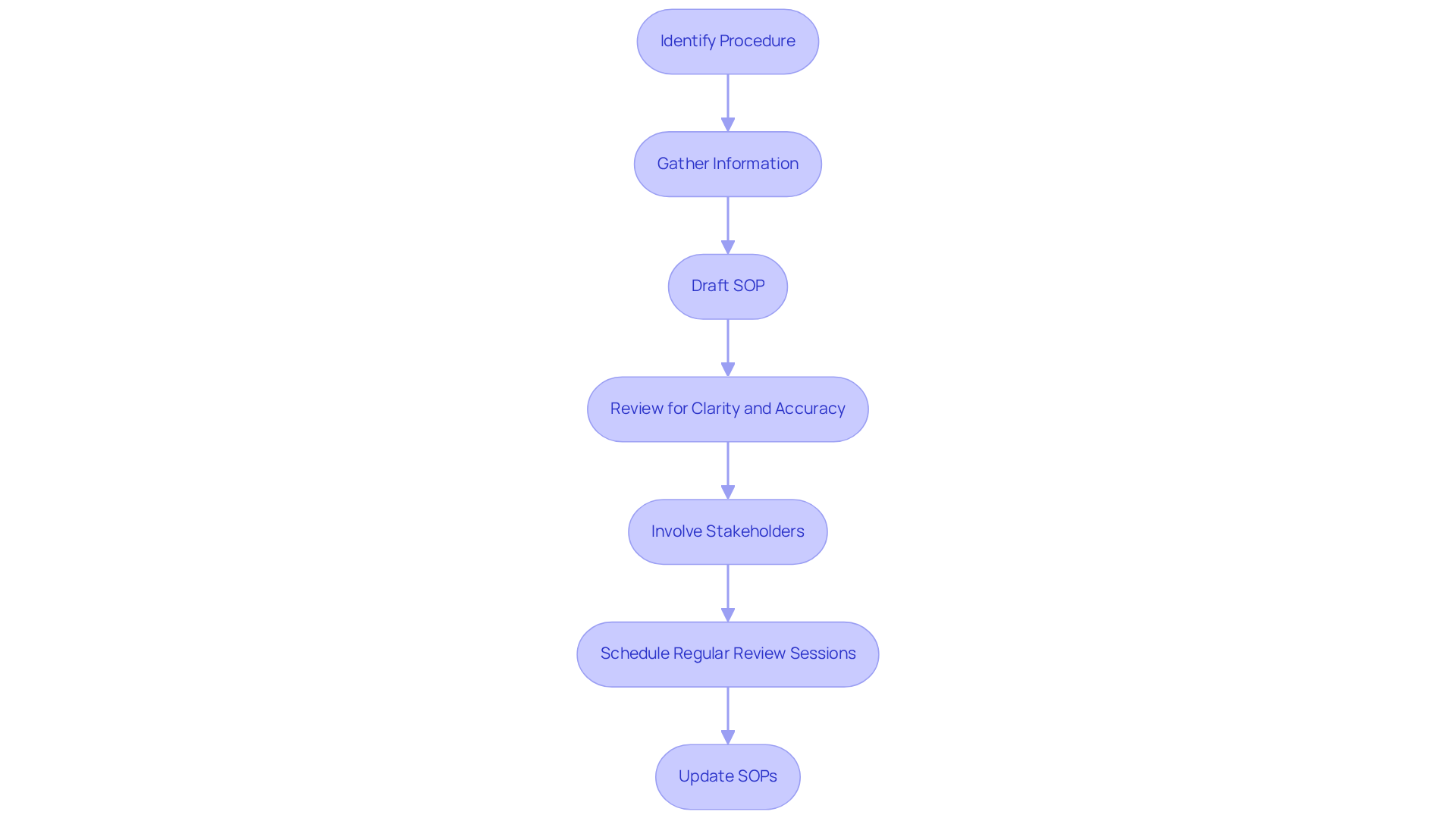
Leancommunity.org: Practical SOP Examples for Manufacturing
You might be wondering where to find practical SOP examples that really fit your manufacturing needs. Well, Leancommunity.org has got you covered! They offer a variety of examples tailored specifically for manufacturing settings. These examples dive into different aspects of manufacturing processes, like:
- Equipment operation
- Safety protocols
- Quality control measures
By checking out these examples, you can gain valuable insights into effective SOP structures and language that you can easily adapt to meet your specific operational needs. So, why not take a look and see how they can help streamline your documentation?
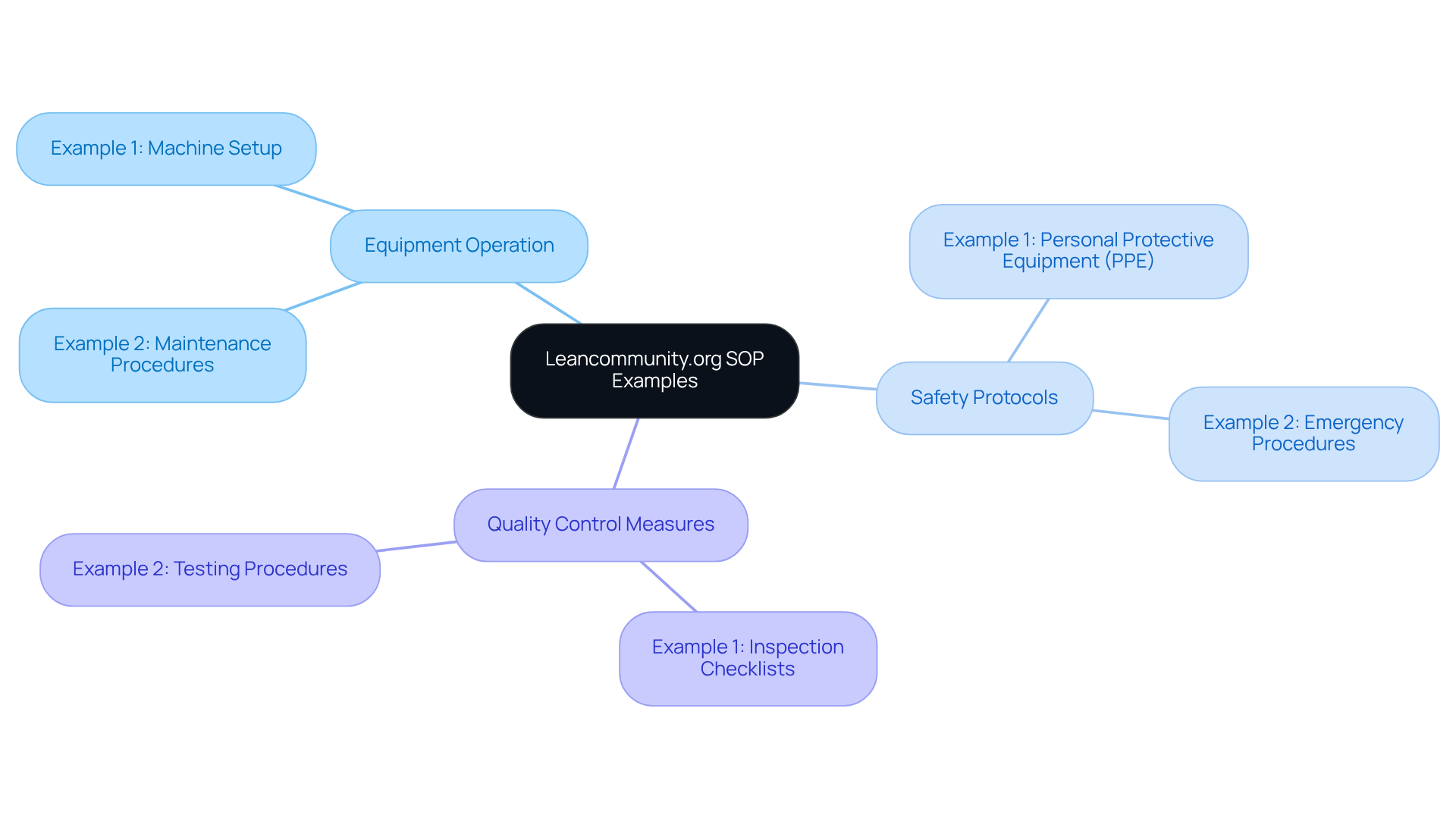
PKC India: Importance of SOPs for Compliance and Quality Control
You might be wondering just how important manufacturing SOP examples are in the context of manufacturing. Well, PKC India highlights their crucial role in ensuring compliance and quality control. Think of SOPs as your go-to guide—they outline all the necessary steps to meet regulatory standards while keeping product quality in check. By putting strong SOPs in place, organizations can really cut down the risk of non-compliance, which is key to maintaining a good reputation in the market.
For example, companies that have embraced robust SOPs have seen a whopping 20% boost in productivity and a significant drop in defects. That's a clear sign that effective SOPs can lead to better operational performance! One well-known electronics producer even achieved a 30% reduction in defect rates by implementing real-time monitoring and training. Isn't that impressive? It really shows how SOPs can make a big difference in quality control.
But there’s more! Organizations that focus on SOPs often enjoy happier customers. When quality is consistent, it builds trust and reliability in their products. Take a textile firm, for instance—they improved product uniformity and reduced customer complaints by investing in training for their machine operators. This just goes to show how standard procedures can enhance customer satisfaction.
In today's competitive landscape, using SOPs strategically not only streamlines operations but also helps companies stand out as leaders in quality assurance, paving the way for long-term success. And don’t forget, keeping SOPs updated is crucial to stay in tune with evolving technologies and regulations. As someone once said, 'SOPs are essential for businesses, particularly in manufacturing, and manufacturing SOP examples are crucial to ensure consistency, safety, and efficiency.' So, let’s dive into how you can make the most of SOPs in your own operations!
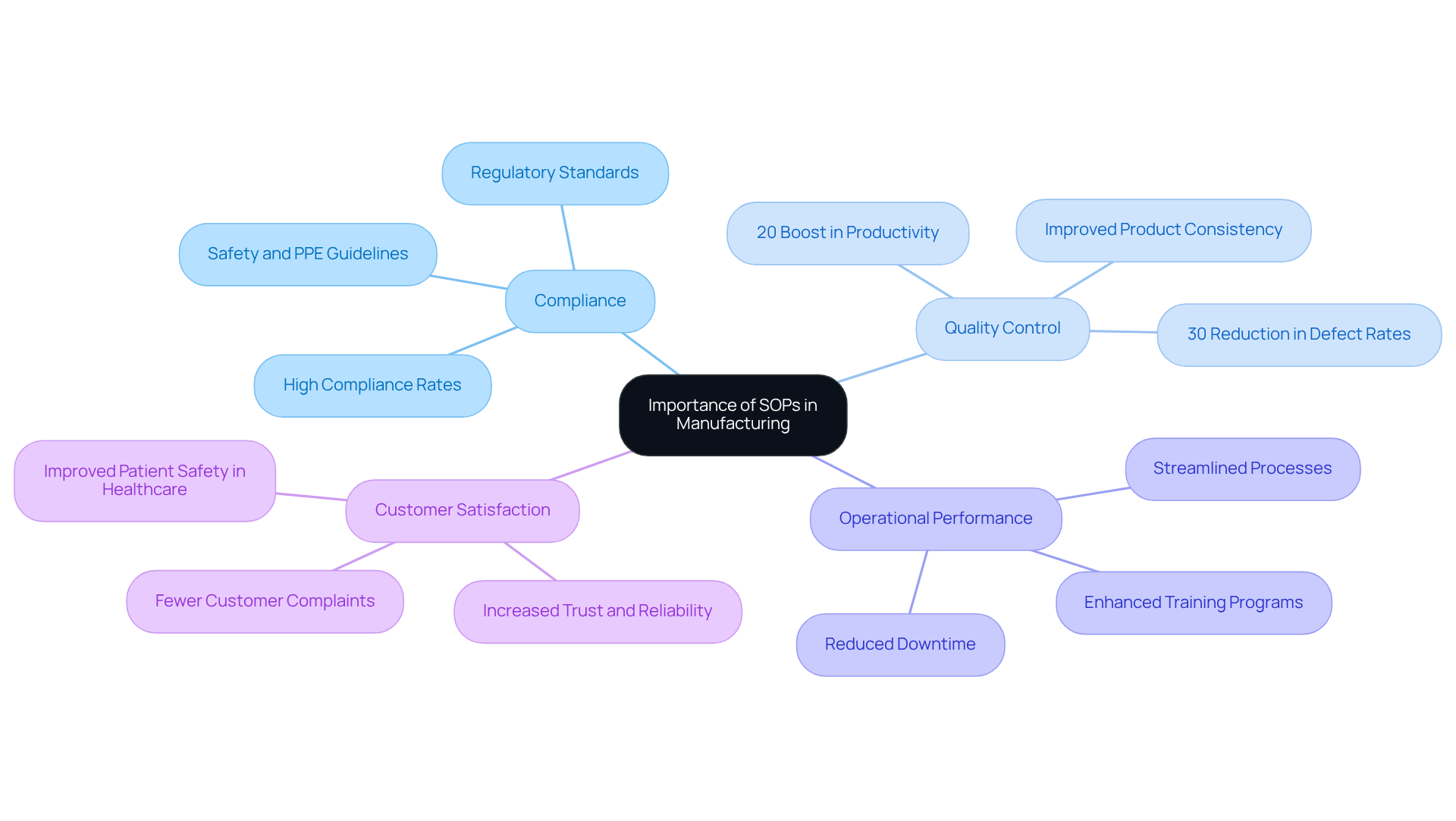
SweetProcess: Benefits of Digital SOPs for Streamlined Operations
You might be wondering about the benefits of adopting manufacturing SOP examples as digital standard operating procedures in manufacturing. Well, SweetProcess highlights that these digital SOPs are not only easier to update, share, and access, but they also cut down the time you spend on managing documentation. Plus, they can include multimedia elements like videos and images, which really helps in making things clearer and more engaging for your team. This move to digital documentation doesn’t just streamline operations; it also nurtures a culture of continuous improvement.
Now, here’s something interesting: companies that implement these SOPs often see a significant drop in defect rates. In fact, some report improvements of up to 30% in product consistency! And if you’re using SowFlow's digital documentation tools, you’ll likely notice an increase in operational efficiency, as you’ll spend less time hunting for information. In today’s fast-paced world, where a whopping 80% of organizations face challenges due to outdated digital technologies, switching to digital SOPs is crucial for staying competitive.
Research even shows that effective standard operating procedures can reduce training time by around 30%. That really underscores the operational perks of going digital! Overall, embracing digital standard operating procedures, including manufacturing SOP examples, is key to boosting productivity and ensuring that your manufacturing operations are agile and ready to adapt to change.
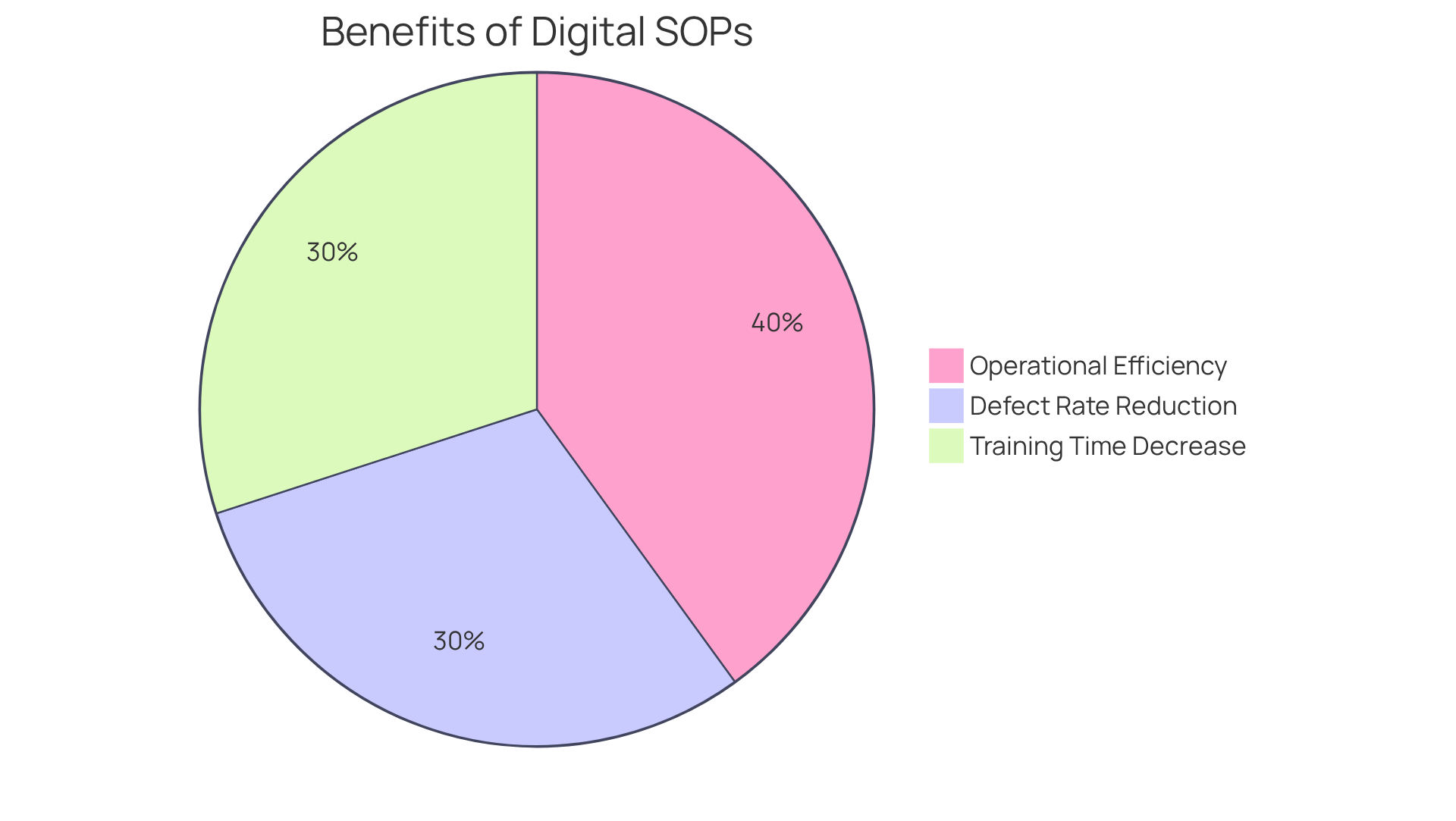
The FDA Group: Essential Components of Effective SOPs
You might be wondering what makes manufacturing SOP examples truly effective. Well, the FDA Group highlights some key ingredients:
- A clear title
- A purpose statement
- Scope
- Responsibilities
- Detailed procedures
And don’t forget about including a revision history and those all-important approval signatures to keep everyone accountable. By weaving these elements together, organizations can create manufacturing SOP examples that not only meet regulatory standards but are also super practical for day-to-day operations.
Now, let’s dive into how SowFlow’s instant documentation solution can make your life easier. With this tool, teams can whip up and update their SOPs in no time, ensuring they stay relevant and easy to find. This means operations managers can simplify the whole procedure standardization process, making onboarding smoother and encouraging knowledge sharing among team members. Ultimately, this boosts team efficiency, and who doesn’t want that?
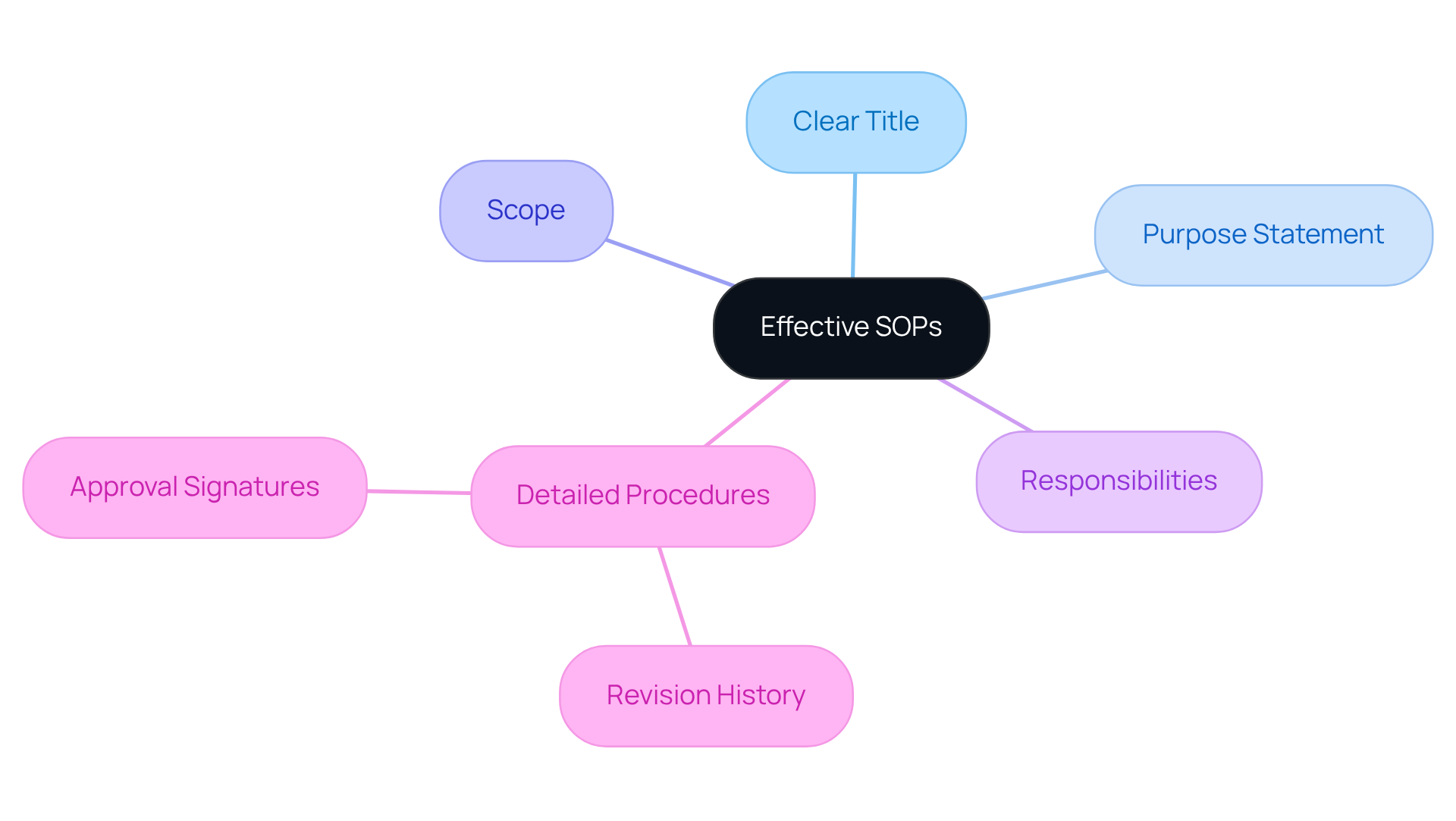
Pressbooks: Understanding the SOP Lifecycle for Continuous Improvement
You might be wondering about the SOP lifecycle, right? Well, it’s all about creation, implementation, review, and revision. But here’s the kicker—ongoing enhancement is super important! Companies need to regularly check in on their SOPs to make sure they’re still relevant and effective. Involving employees in these review activities can really pay off, too. Their feedback and insights can lead to better documentation practices and boost operational efficiency.
Research backs this up! It shows that when companies actively involve their employees in SOP reviews, they see a significant boost in adherence and understanding. In fact, there’s a strong correlation—0.816 to be exact—showing how SOPs and the workplace environment impact employee performance. Companies that set up structured review cycles often report big gains in productivity and quality assurance. Why? Because standardized processes help ensure quality and improve everyone’s understanding of the processes.
But let’s be real—challenges do exist. Things like inadequate resources and poor monitoring can really throw a wrench in effective SOP management. So, what can companies do? By focusing on regular reviews and tapping into employee insights, they can foster a culture of continuous improvement. This not only drives efficiency but also makes operations more effective. Now, doesn’t that sound like a win-win?
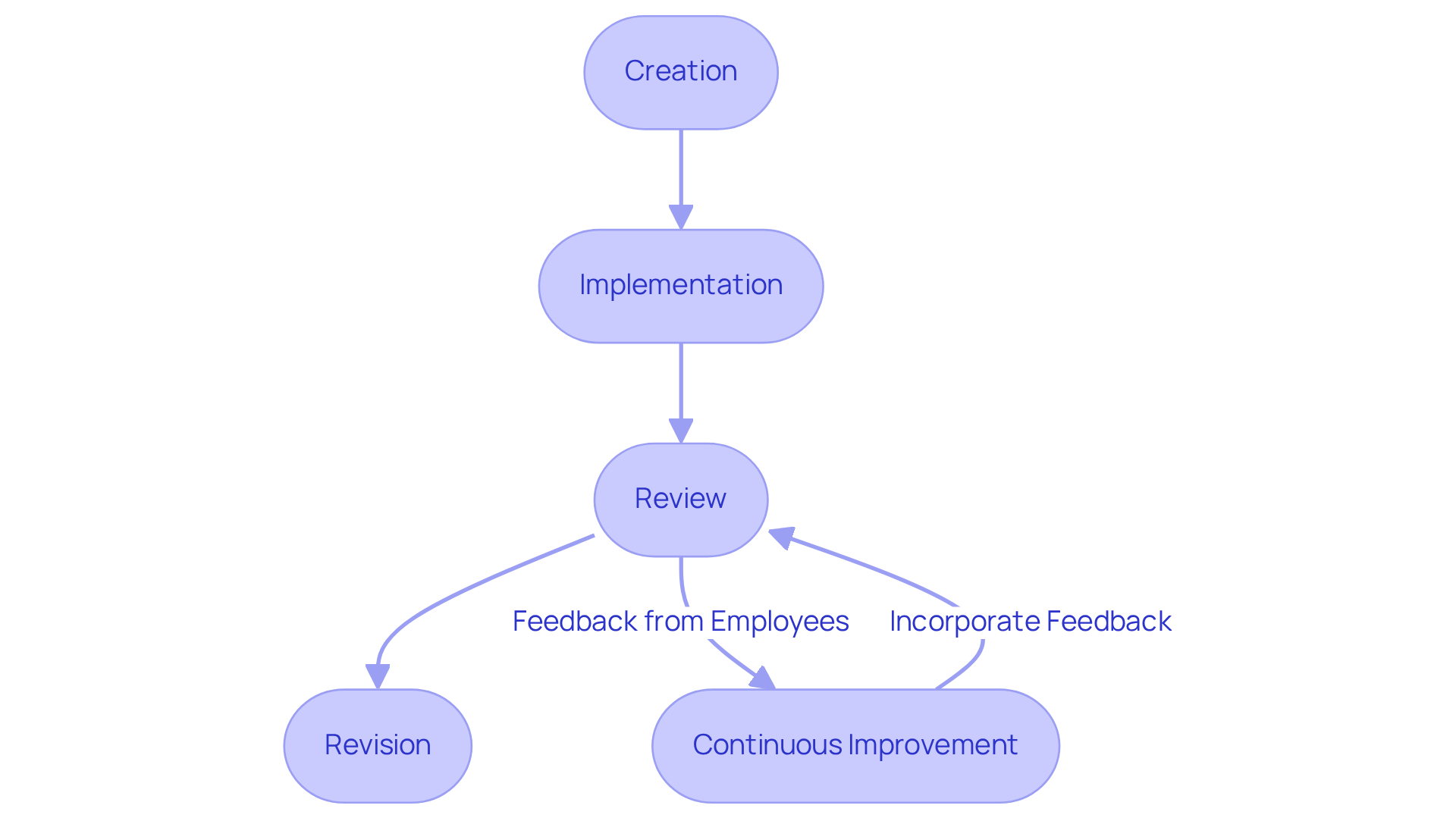
Ease.io: Risks of Non-Compliance with Manufacturing SOPs
You might be wondering about the risks of not adhering to manufacturing SOP examples. Well, let me tell you, they can be pretty significant! We're talking about legal penalties, product recalls, and a hit to your reputation. The stats are quite alarming—product recalls due to SOP failures happen more often than you might think, which really highlights the importance of following these protocols closely.
Imagine this: if a company overlooks compliance, it can face operational hiccups that not only halt production but also lead to some serious financial losses. And the financial implications? They can be harsh! Companies could end up paying hefty fines and legal costs, just like those businesses that faced penalties for not meeting regulatory standards.
Plus, let’s not forget about the reputational damage. Non-compliance can really erode customer trust, making it super important for organizations to create and adhere to comprehensive manufacturing SOP examples. By prioritizing compliance, companies can safeguard their operations, boost their market position, and build trust with customers and regulatory bodies. So, what do you think? Isn’t it worth it to focus on compliance?
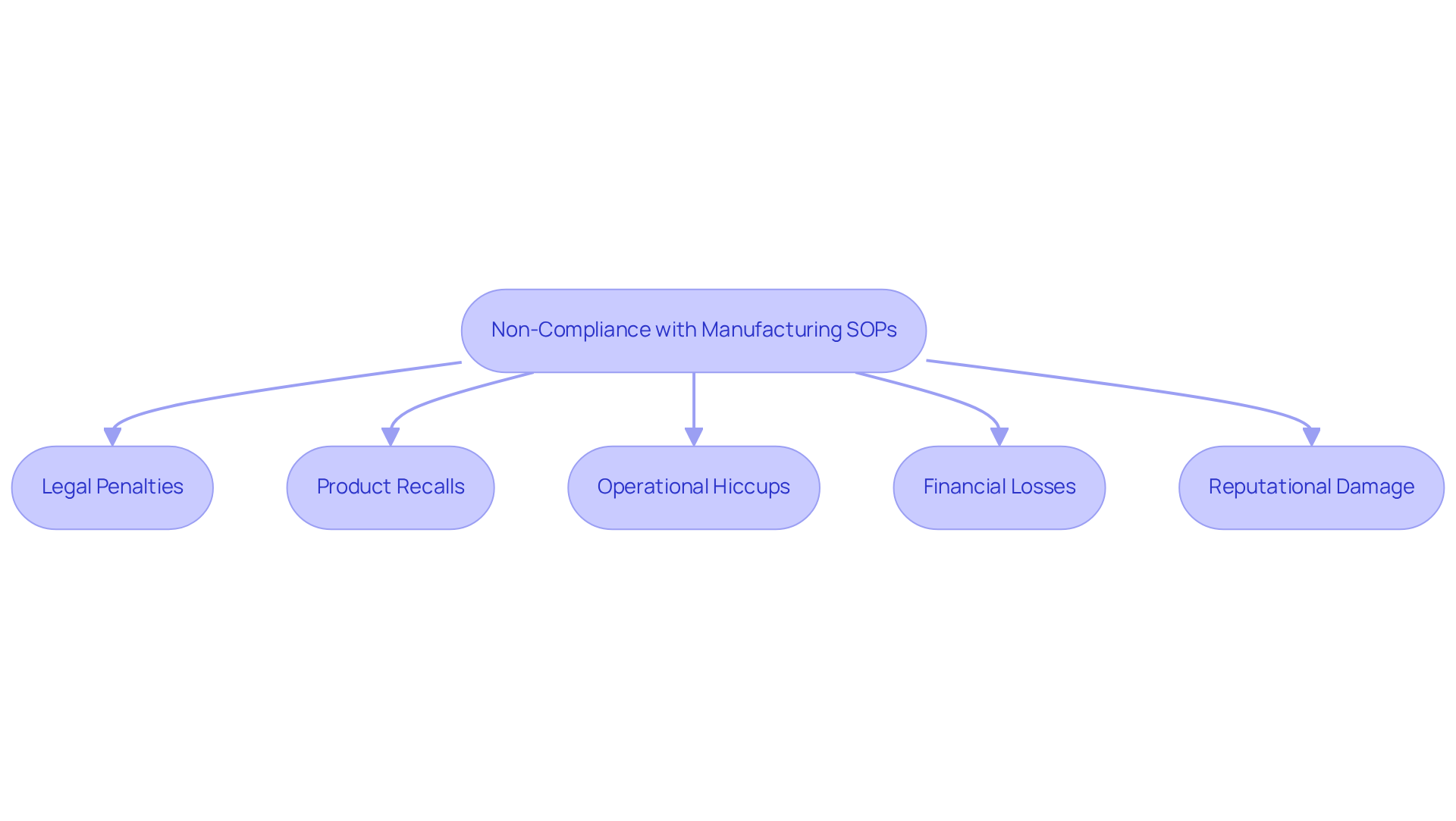
Conclusion
In the world of manufacturing, you might be wondering just how crucial standard operating procedures (SOPs) really are. Well, they’re the backbone of operational efficiency, quality control, and compliance. By embracing effective manufacturing SOP examples, organizations can streamline their processes, ensuring everything runs smoothly and aligns with industry standards. This not only boosts productivity but also cultivates a culture of continuous improvement among the team.
Now, let’s dive into the key insights we’ve explored about tools and strategies for creating and managing manufacturing SOPs. From the user-friendly documentation features of SowFlow to the practical examples shared by Leancommunity.org, it’s clear that harnessing technology and established practices can significantly amp up the effectiveness of SOPs. Plus, the focus on regular reviews and updates underscores the need to stay relevant in our fast-paced manufacturing world.
Ultimately, adopting well-crafted SOPs is a must for any organization that wants to thrive in today’s competitive landscape. The risks of non-compliance and outdated procedures can really take a toll, affecting both reputation and operational success. So, by embracing the principles we’ve discussed, you’re not just safeguarding compliance; you’re positioning your organization for long-term operational excellence. Taking action to implement and continuously refine manufacturing SOPs is a crucial step toward maintaining success and reliability in the manufacturing sector. What are you waiting for? Let’s get started!
Frequently Asked Questions
What is SowFlow and how does it help in creating manufacturing SOPs?
SowFlow is a tool that simplifies the creation of manufacturing Standard Operating Procedures (SOPs) by allowing teams to record workflows directly from their browser, which enhances efficiency and accuracy in documentation.
How does SowFlow improve operational efficiency?
SowFlow reduces the time spent on paperwork, enabling teams to focus on core operational tasks, thereby boosting productivity and ensuring that documentation remains relevant and up-to-date.
What are the benefits of using SowFlow for manufacturing SOPs?
The benefits include streamlined process standardization, enhanced onboarding, better knowledge sharing, and the creation of clear, concise SOPs that improve team efficiency.
Why is creating manufacturing procedures important?
Creating manufacturing procedures is crucial for ensuring quality, reducing errors, boosting operational efficiency, and maintaining compliance with regulatory standards.
How can effective manufacturing SOP examples impact compliance and quality?
Effective SOPs help organizations align with quality benchmarks, reduce operational risks, and improve product reliability by providing a consistent framework for employees to follow.
What features should be included in manufacturing SOPs to enhance usability?
Incorporating visual aids like flowcharts and diagrams, as well as a clear numbering system, can simplify complex processes and make SOPs easier to understand and follow.
What is the importance of regularly updating SOPs?
Regularly monitoring and updating SOPs is essential to keep them relevant and effective, allowing them to evolve alongside changing regulations and industry practices.
Can you provide an example of how SowFlow has benefited a user?
Anastasia Masadi, a Product Owner, noted that SowFlow has transformed their documentation process by allowing them to create SOPs without exiting the browser, saving time and improving efficiency in delivering work to clients.
👍
What others are liking
5 Steps to outline your ideal documentation structure
5 MINS READ
Where to start the your journey of mapping out your ideal documentation structure, aligning it with the very heartbeat of your organization?
Defining a winning level of detail in your process
3 MINS READ
What is too much detail, and what is too little? This article described in that winning level detail about what detail is enough.





